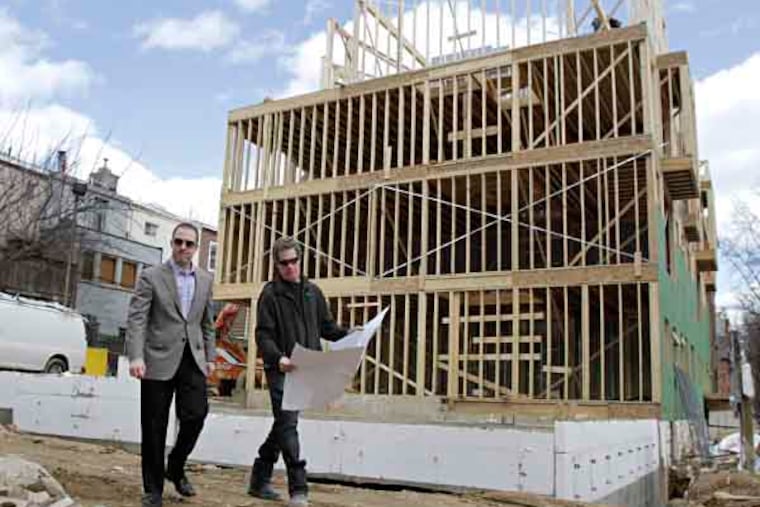Builders cautiously getting back to work
Their numbers are fewer - construction financing has loosened only a bit, and rising costs for materials still chip away at near-to-bottom profit margins - but small and medium-size builders are back.

Their numbers are fewer - construction financing has loosened only a bit, and rising costs for materials still chip away at near-to-bottom profit margins - but small and medium-size builders are back.
They're carefully picking locations and collecting data on buyers, desired amenities, and alluring price points. They're also building fewer houses and more manageable developments that won't end up with unsold units.
Credit standards and requirements are much more rigid and expensive.
"There is a different mood now," said South Jersey builder Bruce Paparone, who recently met with one of his lenders. "The banks want minimal risk to lend you money."
Some national builders with deeper pockets will build a few more homes on speculation, Paparone said, but most locals, including himself, are building just a couple per project for quick delivery.
There is neither enough anecdotal nor statistical evidence to know whether this a trend across the country, said Stephen Melman, director of economic services for the National Association of Home Builders in Washington.
"Builders always have a targeted market in mind, and that principle applies during good times and bad," Melman said. Though annual reports from the large publicly held companies show the number of communities they are building in, he said, "the details are not sufficiently precise for me to conclude that they are building more slowly, or in phases."
Even as residential construction starts to ramp up, reminders of past mistakes abound. The landscape is still littered with foreclosures and rotting signs heralding projects that never made it out of the planning stages.
Important to today's strategy is understanding "why people don't buy houses" as well as why they do, said developer Noah Ostroff, who with his three partners is building Lombard Estates at 18th and Lombard Streets.
Developers got into trouble when they assumed buyers would pay any price, no matter the location, said Ostroff, an agent with Coldwell Banker Preferred. When houses didn't sell, the prices dropped below building costs, and those same builders were forced into foreclosure.
That experience has made builders today more conservative in their approach - in what they will pay for land and in pricing vs. amenities, he said.
Pace of construction, of course, depends on demand.
Lombard Estates will have 11 homes. At first, Ostroff and his partners were going to build, but at the time they broke ground, they had five buyers, so they built five houses. At this point, they have eight buyers spending $1 million and more, he said.
Bad timing was fatal to many housing-boom-era developers, but buyers in a destination neighborhood that's short of supply appear willing to wait for their houses, said Marie Gordon, of Prudential Fox & Roach of Wayne.
She is handling sales at Stephen Goldner's 32-townhouse Kingsley Court in Roxborough. There have been delays and the houses are not expected to be completed until late in the summer, but the five buyers who have signed agreements of sale at a preconstruction price of $334,500 are undeterred, she said.
Some locales in the Philadelphia region have a limited amount of buildable land and few existing houses for sale, but homes are in high demand - especially by empty-nesters.
Narberth has perhaps five vacant lots, "side yards, actually," said John Duffy, of Duffy Real Estate, and there have been at least two instances of duplexes being converted into single-family homes.
Final approval is being awaited for an 11-unit condo project at the former Narberth Methodist Church and its property, Duffy said, but much development there focuses on rehabbing homes "in need of work" for resale.
In Doylestown and West Chester, condos are the major focus.
Veteran broker Nicholas Molloy, of J. Carroll Molloy Realtor in Doylestown, is ready to take deposits on 20 2,000-square-foot, single-level condos with underground parking at the Enclave at Nyce's Mill, which he is selling for builder Joseph Ventresca.
"Land is dear, and builders are very cautious," said Molloy. A lot of builders "lost their shirts, which is a shame because there are many good opportunities."
Kit Anstey, of Prudential Fox & Roach, who is handling sales of Union Station condos in West Chester for the Ingerman Group, said other legacies of the economic downturn haunt the market.
Qualifications for Fannie Mae- and Freddie Mac-backed mortgages have changed, increasing the percentage of pre-sales and limiting investor numbers, which make financing more challenging, Anstey said.
"And while buyers seem more eager in this market to pay a little more than they have been, changes in the [valuation] process since the downturn usually means they won't appraise" at higher prices, he said. "It weighs heavily on the market."